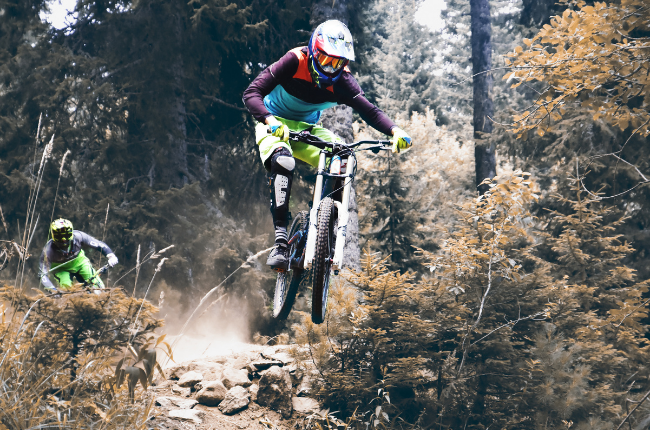While fun for bored youth, these bike facilities pose a serious problem for councils. Not only are there safety risk and potential legal ramifications, but there’s environmental damage to consider too.
So how should you stay on top of this growing trend, without being the ‘fun police’? In this article, we explore different strategies to consider.
The rise of make-shift facilities
The recent spate of lockdowns and travel restrictions have left a lot of youth in NSW with idle time. And with the lack of established facilities in some LGAs, many young people started getting creative. By building their own mountain bike and BMX bike trails, pump tracks and dirt jumps.
These facilities are fun and exciting, allowing people to zig and zag and soar sky high with a well-timed run. But they’re also completely unauthorised.
While this is not a new problem, there’s been a marked increase in recent months – fuelled by lockdowns, travel restrictions and boredom.
And while we do see many of these make-shift facilities appearing in bushland, it’s not just an issue for rural NSW. Urban areas are increasingly being impacted too.
Risk to the community and the environment
Unauthorised bike facilities may look harmless. But because they’re built unprofessionally, they can pose serious safety and environmental risks.
- Risk to the rider
Unauthorised trails and jumps may not meet required safety standards.
Some are poorly constructed, while the level of difficulty in others may not be immediately clear to riders. These facilities pose a huge safety risk as riders can get seriously hurt in falls and accidents.
- Risk to the public
The construction of these facilities can also pose a risk to people who are visiting or accessing the area.
Passers-by can get struck by riders, and loose debris can create unsafe walking conditions. In fact, some unauthorised bike tracks cut into existing walking trails, making it hazardous for pedestrians.
- Environmental damage
In the wrong hands, shovels and mattocks can wreak havoc across natural landscapes and damage surrounding environments. This can lead to erosion, destruction of habitats, and intrusion upon indigenous lands.
Using the wrong materials can also harm the ecosystem and pose a risk to endangered species.
The challenge for councils
Dealing with unauthorised facilities is no easy feat. Why? Because with vast amounts of land to oversee, and so many locals ready to take trails into their own hands, these bike facilities can pop up quickly (and in great numbers).
And even when a council does locate a trail, they still need to allocate workers and equipment for an effective response.
There’s also the question of how to appease the community. As in many cases, locals work tirelessly to build their trails, tracks and jumps, so charging in with a bulldozer may not be the best move. If the council isn’t careful, this could end up causing reputational damage instead.
What councils can do
Many councils have a reactive approach to managing unauthorised bike facilities. But this is not an effective long-term solution to the issue.
Instead, you should establish how you plan to manage unauthorised bike facilities and develop a documented strategy moving forward.
There are several approaches you can take:
- Blanket removal: This zero-tolerance approach means all unauthorised facilities are removed immediately once found.
- Prohibition: Ban certain activities from taking place on council-managed land.
- Retention: Retain and monitor areas with low-risk, low-impact tracks, jumps and trails.
- Risk removal: Remove facilities that may be unsafe or that pose an unacceptable risk to the community and the environment.
- Consultation: Speak to affected sections of the community (including cycling groups or other users) and external stakeholders (such as State Forests and National Parks) to find an appropriate solution.
As the magnitude and individual circumstances of unauthorised facilities may vary between LGAs, you may consider adopting a few strategies instead of going with just one hard line approach.
To decide on the strategy that works best for you, consider:
- The frequency of unauthorised facilities emerging
- The volume and locations of these bike facilities
- The frequency of use
- Whether these activities and conditions are allowed or prohibited in plans of management
- Your level of knowledge on the issue
- The level of risk associated with each facility
- What may constitute a reasonable response
- The resources available for effective strategy implementation
Most importantly, engage your community
No matter what strategy you decide to take, it’s critical that you keep the conversation going with your community.
Find out what their needs are. Understand what they want. Take a look at the bigger picture and ask yourself: is there a lack of formalised facilities within your LGA? And is it time to do something about it?
When you provide well-designed and well-constructed facilities that meet the needs of the cycling community, the number of unauthorised bike trails will likely decrease.
Where to go from here
The first thing to do is establish your position in managing unauthorised bike facilities in your LGA – through formalised policy or directive.
Then, communicate your position to the public and support it with well-designed signage in the area.
For guidance on how best to go about this, speak with your Regional Risk Manager at Statewide Mutual.
Looking for inspiration? Learn how community and council came together to build the Golden Jubilee Bike Park.

